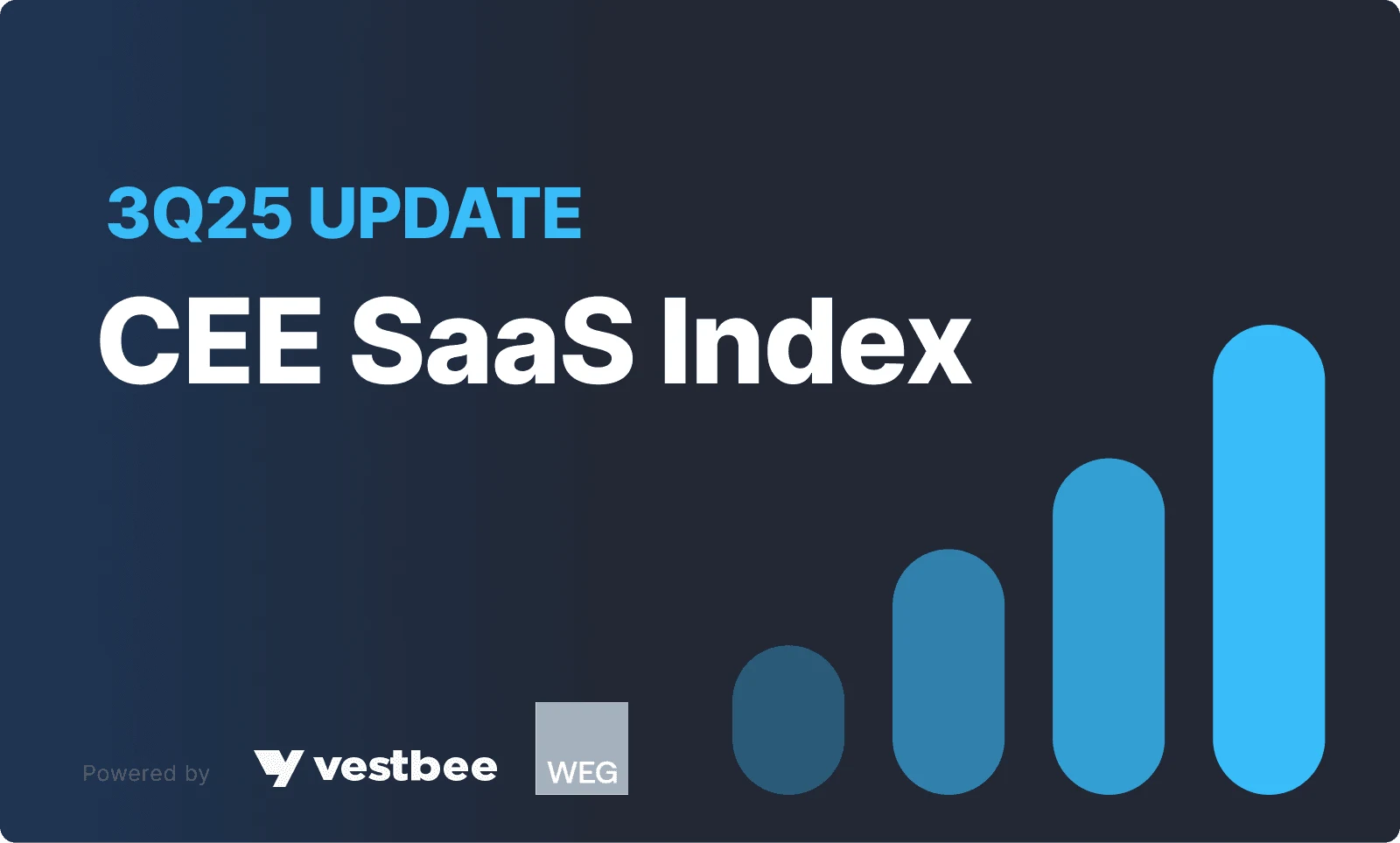After years of economic turbulence caused by pandemic aftershocks, inflationary pressures, and the ongoing war in Ukraine, the M&A market regained momentum in 2024. A key trend was the shift in corporate M&A strategies. Instead of volume-driven deals, firms prioritized transformational and horizontal acquisitions aimed at strengthening resilience, digital capabilities, and AI-driven efficiencies. AI innovation played a pivotal role, driving activity across multiple industries.
Vestbee conducted an in-depth analysis of the global, European, and CEE M&A landscape to identify key trends shaping dealmaking in 2025.
M&A market globally
In 2024, the global M&A market showed signs of recovery, with total deal value rising by 5% year-over-year. However, deal volume declined by 17%, highlighting a shift towards fewer but higher-value strategic deals. Tighter credit conditions, rising interest rates, and cautious private equity funding primarily drove this divergence.
Mid-market deals struggled, as many investors stayed on the sidelines due to uncertain conditions; meanwhile, major corporations capitalized on market turbulence to drive multi-billion-dollar acquisitions. These high-value transactions ensured that deal momentum remained intact despite broader market hesitancy.
Sectoral trends and AI dominance
Technology remains the driving force behind M&A, with AI-related deals dominating the landscape. Some of the most prominent AI transactions were Cisco’s $28 billion deal for Splunk, IBM’s $6.4 billion acquisition of HashiCorp, Nvidia's latest $250 million purchase of OctoAI.
Beyond AI, financial services also experienced significant growth, with banks and private credit firms merging to gain scale and operational efficiency in an increasingly digitized economy. Similarly, aerospace and security deals gained traction, fueled by geopolitical tensions and rising defence budgets that spurred consolidation.
However, not all industries thrived. Pharmaceuticals and life sciences — historically strong M&A sectors — saw a 36% YoY drop in deal value, largely due to regulatory hurdles, increased scrutiny of pricing practices, and a shift in investment priorities toward AI and digital transformation. Traditional healthcare segments, once highly favoured for M&A, also saw a slower deal flow as capital was reallocated to high-growth technology sectors.
On the global scale, the largest M&A deals in 2024 included Couche-Tard’s $39 billion acquisition of Seven & i Holdings, Capital One’s $35.3 billion purchase of Discover Financial Services, and Synopsys’ $32.5 billion takeover of Ansys.
Cross-border M&A activity
The strengthening of the US dollar in 2024 gave American firms a unique advantage in cross-border M&A, allowing them to acquire undervalued international assets. This fueled a wave of outbound deals as capital freely flew to many parts of the world, fueling local ecosystems. Japan and India emerged as standout performers, registering respectively +24% and +20% in deal value growth.
Yet, political shifts and regulatory scrutiny presented challenges, particularly in US-China dealmaking. Semiconductor acquisitions, for example, became a flashpoint as national security concerns led to intense regulatory barriers and government intervention.
Rising protectionism and the aftermath of the 2024 US elections added further uncertainty, with analysts debating the potential ‘Trump effect’, a possible deregulation wave that could contribute to the reignition of the M&A market, sparking activity in sectors such as biotech and healthcare.
Some of the key investor takeaways:
- Rising interest rates and increased borrowing costs weakened the traditional PE playbook. Instead of leveraged buyouts, PE firms pivoted toward strategic partnerships, minority stakes, and bolt-on acquisitions that required less debt financing.
- Tech M&A remained strong, particularly in AI-driven deals. Companies sought cutting-edge intellectual property and top-tier engineering talent, reinforcing the shift toward talent-driven acquisitions.
- The transition to clean energy and ESG-driven investment strategies fueled M&A activity in renewables, sustainable infrastructure, and green technology. Investors continue to prioritize sectors aligned with regulatory incentives and long-term sustainability goals.
European M&A: beyond the core markets
In Europe, M&A expanded beyond the usual powerhouses of the UK, Germany, and France. Smaller markets — such as Denmark, Ireland, and Spain — saw a rise in major transactions. Notably, the CEE region’s countries had established themselves as strong players — particularly Romania, Poland, and the Czech Republic. It had emerged as a key hub for acquisitions, driven by GDP growth, outsourcing potential, and untapped market opportunities.
Despite the rise in overall deal value, driven mainly by a few high-value deals, mid-market M&A continued to struggle. Similarly, VC-backed tech firms saw a decline in M&A activity compared to previous years. Among the standout European transactions were:
- EyeBio, a London-based biotech, was acquired by Merck for $1.3 billion upfront, with a total potential deal value of $3 billion.
- WeTransfer, a Dutch file transfer startup, was acquired by Bending Spoons, an Italian unicorn, for $700 million.
In line with global trends, Europe’s M&A market has also seen a steady shift toward cross-border transactions, which now account for 42% of total deals (up from 38% in 2004). This trend is particularly evident in smaller economies such as Finland, Ireland, and the Czech Republic, where foreign acquirers drive a significant share of deal volume. By contrast, larger economies, like the UK, Germany, and France, still maintain high domestic consolidation.
Regarding sectoral trends, the European M&A market remained highly diversified, with no industry accounting for more than 13% of total deal volume. The top-performing sectors in 2024 included:
- Software & Services. Software acquisitions grew at an 18% CAGR from 2004 to 2024, with deal volume rising from 148 to 3,414 transactions.
- Consumer Goods & Industrials. Attracting strategic and financial buyers due to resilience in economic downturns.
- Healthcare. Biotech and medtech acquisitions remain strong, driven by ageing demographics and advances in personalized medicine.
- Energy & Renewables. Benefiting from the global shift toward sustainable energy and strong investor interest fueled by government incentives.
Looking into the CEE market
The CEE region saw a dynamic year in 2024, with M&A deal volume reaching its highest since 2018. However, the total disclosed deal value dropped by 30% due to a lack of megadeals exceeding €1 billion. This signals a regional shift towards strategic, mid-sized acquisitions rather than blockbuster transactions.
Regional leaders: Poland, Czechia, and Slovakia at the forefront
Poland, the Czech Republic, and Slovakia emerged as the region’s leaders, benefiting from foreign investment, relatively stable domestic deal flow, and resilient startup ecosystems. Major transactions reflected a clear focus on strategic consolidation. The year’s largest deal, Energetický a Průmyslový Holding’s €3.99 billion acquisition of a 33% stake in Slovenské elektrárne, exemplified this trend. Companies generally focus on strategic add-ons, industry consolidation, and long-term resilience rather than riskier, high-value acquisitions.
Geopolitical tensions and cross-border investments
Even though the CEE region remains undervalued compared with Western Europe, its attractiveness is tempered by geopolitical and macroeconomic forces — most notably, the ongoing war in Ukraine. This leaves investors cautious about energy dependencies, supply chain risks, and regulatory volatility.
Despite these challenges, US investors expanded their presence in the region, executing more than 100 deals (+6.3% YoY) and primarily targeting AI, energy, and manufacturing — sectors aligned with global trends in high-tech and infrastructure investments. Other prominent sources of capital from outside the region included Luxembourg, the Netherlands, Germany, and the UK.
A notable trend was the rise of Middle Eastern investment, particularly in data centres and IT infrastructure. The Saudi Public Investment Fund’s recent acquisitions in Poland and Czechia underscored the region’s growing appeal as a cost-effective, high-growth alternative to Western Europe.
Strategic buyers over PE
In 2024, strategic buyers have increasingly outpaced private equity firms across key technology, manufacturing, and energy sectors. Companies prioritized acquisitions that complement existing operations and aligned with long-term strategic goals rather than financial engineering plays. For private equity, valuation mismatches and high financing costs limited activity, though firms with deep sector expertise found opportunities in AI, cybersecurity, and fintech.
Best-performing sectors: healthcare, telecom, and AI
Healthcare as a magnet for CEE investments
Healthcare emerged as a top-performing sector, driven by demographic shifts, with the region’s ageing population, government-led healthcare reforms, and a wave of technological transformation. Telemedicine, AI-powered diagnostics, and predictive analytics have gained traction, drawing major investor interest. A standout deal was US-based Certara’s acquisition of Hungarian biotech firm Chemaxon.
Pharmaceutical firms also pursued biotech acquisitions to bolster R&D pipelines, further fueling healthcare M&A momentum.
Telecommunications: 5G and digital infrastructure expansion
CEE’s telecom sector saw significant M&A activity as operators sought to expand networks, boost efficiencies, and integrate next-gen technologies like 5G, cloud computing, and IoT. This trend will likely continue in 2025 as governments push for digital transformation and major telcos consolidate regional operations.
AI, cybersecurity and software as key drivers of growth
Strategic acquisitions in AI, cybersecurity, and enterprise software accelerated as companies sought to capitalize on CEE’s highly skilled workforce and lower valuations than Western markets. The region’s expertise in engineering, software development, and cloud infrastructure made it an attractive target for multinational firms looking to scale operations affordably.
What to expect in M&A in 2025
As we enter 2025, stronger valuations, heightened competition, and a shift towards long-term strategic deals are set to shape the global and regional M&A landscape.
- Globally, megadeals seem to be making a comeback, with transactions exceeding $1 billion growing by 17% in 2024.
- Private equity firms, sitting on record levels of dry powder, are expected to increase investments in AI, defence technology, and renewable energy.
- Meanwhile, US regulatory and monetary policy shifts could impact M&A activity in key sectors such as financial services, telecom, and healthcare.
A recovering European public market is expected to drive higher deal valuations, with AI and defence technology leading the charge. However, regulatory scrutiny is increasing, particularly for cross-border tech deals and infrastructure acquisitions. The push toward energy transition will likely remain a dominant force, spurring large-scale M&A in renewables, battery technology, and green infrastructure.
CEE is expected to see intensified telecom consolidation as 5G and fibre broadband investments continue. US private equity firms are set to expand further into AI, fintech, and cybersecurity, targeting scalable businesses with global expansion potential. Meanwhile, Middle Eastern sovereign wealth funds could solidify their role in data centre and IT infrastructure M&A, reinforcing CEE’s appeal as a cost-effective but high-tech market.
Another emerging trend is using AI in dealmaking, where machine learning enhances due diligence, risk assessment, and predictive modelling, making transactions more data-driven and efficient.







